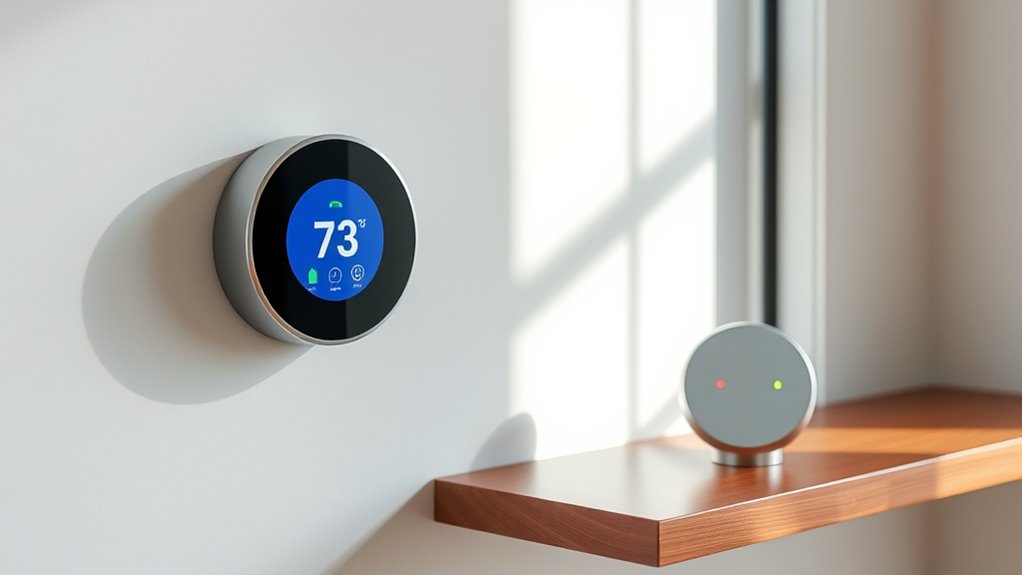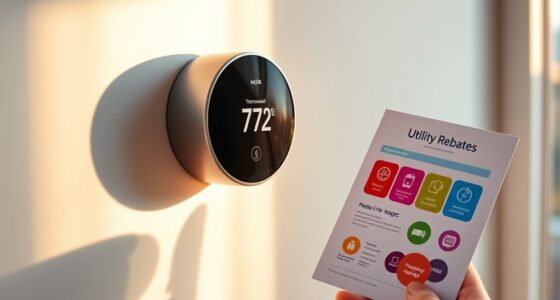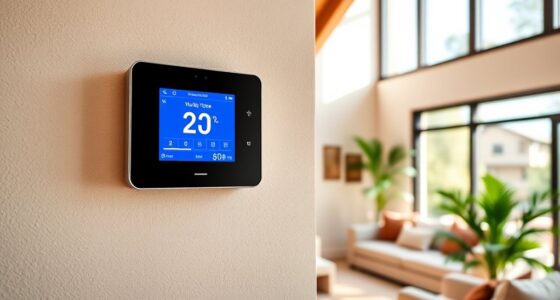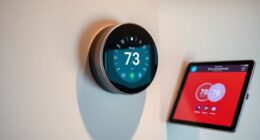When choosing a smart thermostat for air quality monitoring, focus on models that provide real-time data on pollutants, CO2, and humidity. Confirm it’s easy to set up, control remotely via a mobile app, and displays clear air quality metrics. Look for features that automatically adjust your HVAC based on air quality levels, helping you save energy and improve comfort. Keep exploring to find out how to select the best device for your home’s needs.
Key Takeaways
- Prioritize models with comprehensive air quality sensors for pollutants, CO2, and humidity monitoring.
- Ensure the thermostat offers an intuitive user interface and easy setup process.
- Check for mobile app compatibility and remote control features for convenient management.
- Opt for devices that automatically adjust HVAC settings based on air quality data to optimize efficiency.
- Consider energy-saving capabilities that reduce utility bills while maintaining comfort and air quality.
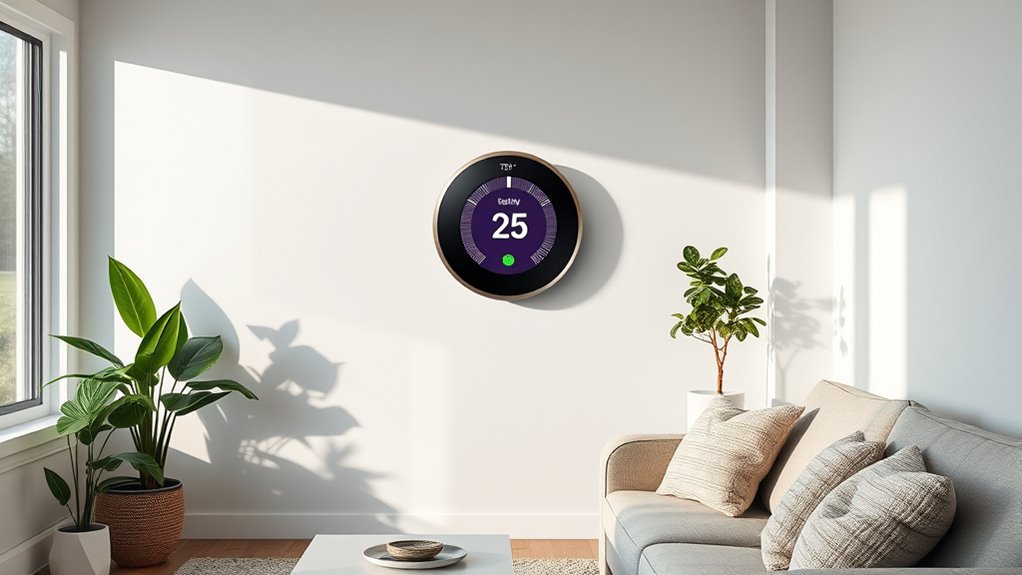
Choosing a smart thermostat that monitors air quality can remarkably improve your home environment. When selecting one, you’ll want to consider how it enhances energy efficiency, helping you save on utility bills while maintaining comfort. A good smart thermostat adjusts heating and cooling based on real-time air quality data, so your home stays comfortable without wasting energy. Look for models with intuitive features that make setup and daily use straightforward. The user interface should be clear, easy to navigate, and accessible from your smartphone or other devices. This way, you’re not bogged down by complicated menus or confusing controls, and you can quickly check air quality levels or adjust settings on the go.
A smart thermostat with air quality monitoring enhances comfort and energy efficiency effortlessly.
Energy efficiency is a vital factor because a smart thermostat that effectively monitors and responds to air quality can optimize your HVAC system’s operation. For example, if the device detects increased levels of pollutants, it can trigger air purifiers or adjust ventilation to improve indoor air. Simultaneously, it guarantees your HVAC runs only when necessary, reducing unnecessary energy consumption. This not only benefits the environment but also lowers your monthly energy bills. Some models even learn your routines over time, automatically adjusting settings to optimize comfort and efficiency without you constantly tinkering with the controls.
The user interface plays a significant role in how well you can interact with your smart thermostat. A well-designed interface should display air quality metrics clearly, such as levels of CO2, humidity, or airborne pollutants. It should also allow you to customize alerts or schedules easily. Many smart thermostats come with mobile apps that mirror the device’s dashboard, giving you full control from anywhere. When choosing, test out how responsive and user-friendly these apps are, as they’re often your main point of interaction. A user interface that’s straightforward reduces frustration and ensures you can promptly respond to air quality issues, whether it’s increasing ventilation or activating air purifiers.
In the end, the right smart thermostat with air quality monitoring features will seamlessly combine energy efficiency with an accessible user interface. It empowers you to maintain a healthier, more comfortable home environment while being mindful of energy consumption. Prioritizing these aspects guarantees you’ll get a device that’s not only smart but also practical, making your home safer and more efficient with minimal effort.
Frequently Asked Questions
Can Smart Thermostats Control Air Purifiers Automatically?
Smart thermostats can often control air purifiers automatically, enhancing energy efficiency and user convenience. They connect to compatible air purifiers and adjust their operation based on air quality data or user preferences. This automation helps maintain healthier indoor air, reduces energy waste, and offers seamless comfort. By integrating these devices, you enjoy a smarter, more efficient home where air quality improves effortlessly and consistently.
Do All Smart Thermostats Support Integration With Air Quality Sensors?
Not all smart thermostats support integration with air quality sensors, so you need to verify thermostat compatibility before purchasing. Some models are designed to work seamlessly with air quality sensors, allowing automatic adjustments for better air quality. If you want to monitor and control air quality, choose a thermostat that explicitly supports air quality sensors. This ensures you get the most effective system for maintaining a healthy indoor environment.
How Often Do Smart Thermostats Update Air Quality Data?
Did you know some smart thermostats update air quality data every 1 to 5 minutes? This frequent data update frequency helps guarantee you get real-time insights, boosting air quality accuracy. You’ll notice that most high-end models refresh sensor readings often, providing more reliable information. This way, you can respond quickly to changes and maintain a healthier indoor environment. Regular updates are key to keeping your air quality monitoring precise and effective.
Are There Privacy Concerns With Air Quality Data Collection?
You might wonder if there’s a concern about data privacy when smart thermostats collect air quality data. While these devices gather useful information, they can also pose risks if data isn’t properly protected. You should make sure sensor security and understand how your data is shared or stored. By choosing reputable brands and reviewing their privacy policies, you can better protect your personal information and reduce privacy concerns.
Which Smart Thermostat Brands Offer the Best Air Quality Monitoring Features?
Imagine your home breathing easier, with air quality sensors that catch every whisper of pollution. Brands like Nest, Ecobee, and Honeywell stand out, offering superior air quality monitoring features. You’ll love how their smart thermostats seamlessly integrate with your existing system, ensuring brand compatibility and reliable data. With real-time air insights, you gain control, comfort, and peace of mind—making your home a healthier haven every day.
Conclusion
Now that you know what to look for, choosing a smart thermostat becomes easier. Many believe these devices only control temperature, but they often monitor air quality too. The truth is, integrating air quality sensors can truly improve your home environment. So, trust the data and pick a model that offers both comfort and cleaner air. Your health and peace of mind depend on making an informed choice—don’t overlook this essential feature.
